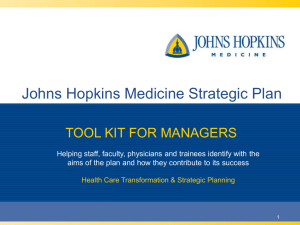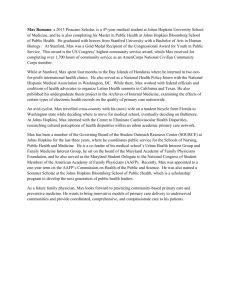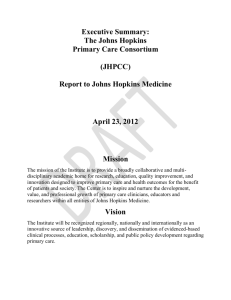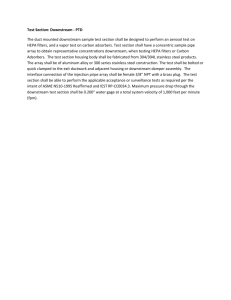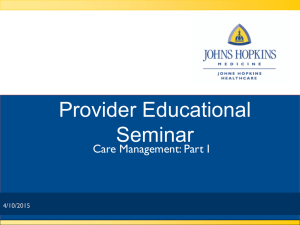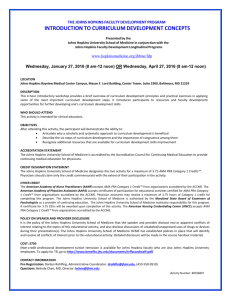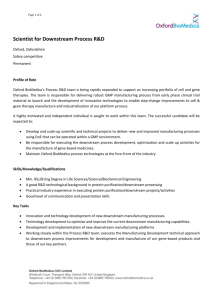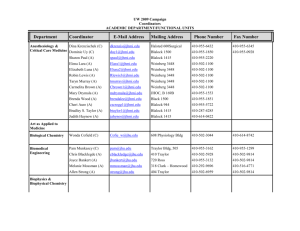Measuring Impact Using a Downstream Revenue
advertisement
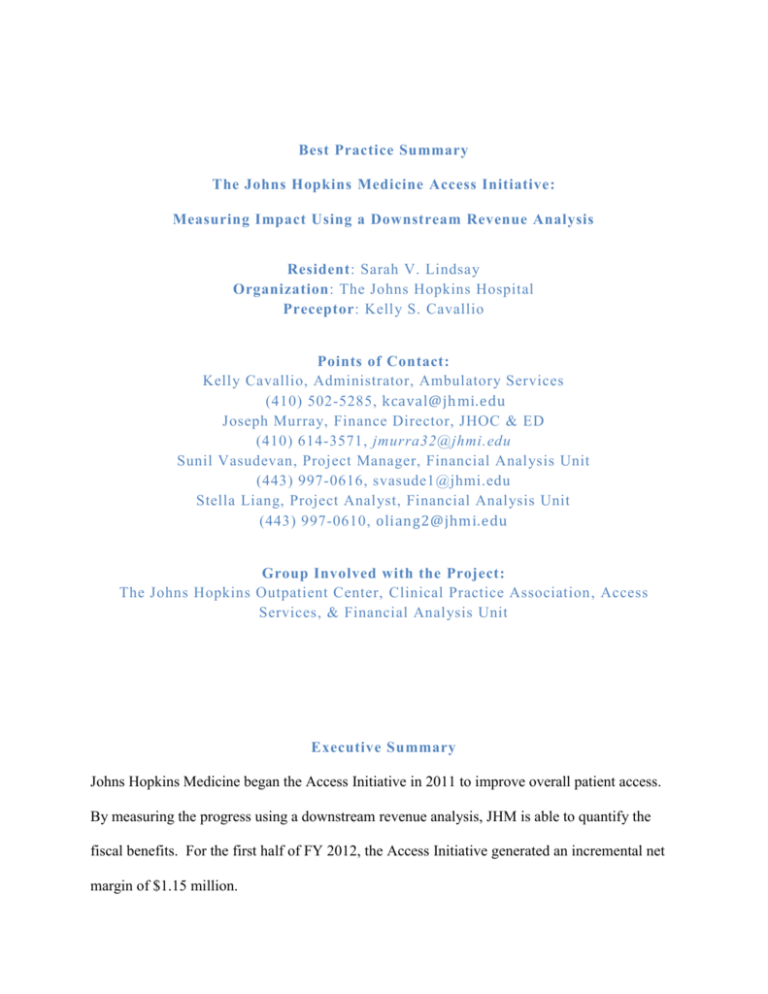
Best Practice Summary The Johns Hopkins Medicine Access Initiative: Measuring Impact Using a Downstream Revenue Analysis Resident: Sarah V. Lindsay Organization: The Johns Hopkins Hospital Preceptor: Kelly S. Cavallio Points of Contact: Kelly Cavallio, Administrator, Ambulatory Services (410) 502-5285, kcaval@jhmi.edu Joseph Murray, Finance Director, JHOC & ED (410) 614-3571, jmurra32@jhmi.edu Sunil Vasudevan, Project Manager, Financial Analysis Unit (443) 997-0616, svasude1@jhmi.edu Stella Liang, Project Analyst, Financial Analysis Unit (443) 997-0610, oliang2@jhmi.edu Group Involved with the Project: The Johns Hopkins Outpatient Center, Clinical Practice Association, Access Services, & Financial Analysis Unit Executive Summary Johns Hopkins Medicine began the Access Initiative in 2011 to improve overall patient access. By measuring the progress using a downstream revenue analysis, JHM is able to quantify the fiscal benefits. For the first half of FY 2012, the Access Initiative generated an incremental net margin of $1.15 million. 1 Objective of the Best Practice The goal of the Johns Hopkins Medicine (JHM) Access Initiative is to improve patient access, resulting in greater patient satisfaction, streamlined referral processes, reduction of readmissions and leakage of patients to outside hospitals in the Baltimore area, and increasing bottom line revenue in order to sustain JHM in the current healthcare environment. Background The Access Initiative began in January 2011 with the leadership of two organizations, the Clinical Practice Association and Access Services. They realized that the current model was not adequate to handle the current patient demand, and so we created the JHM Access Initiative Strategic Plan. It lays out a plan for hiring additional call center and access management staff and provides clinic-level initiatives, such as template management techniques, use of an electronic referral management system, call flow revision, and use of benchmarks and metrics. Literature Review In order to measure the impact of the Access Initiative at The Johns Hopkins Hospital (JHH) and The Johns Hopkins Bayview Medical Center (JHBMC), the committee utilized a downstream revenue analysis. It identifies revenue captured for patient visits after an initial visit at the site of study. While there is very little literature on downstream revenue analyses, one study points out that it does have some limitations, such as requiring extensive methodology refinement and assumptions around the definition of what qualifies as downstream (Petersen, 2007). However, Ohio State University Medical Center utilized the approach to measure the value of its ambulatory care services to reveal the fiscal value to the entire system (Fahey, CruzHuffmaster, Blincoe, Welter, Welker, 2006). 2 Implementation Methods The Financial Analysis Unit performed the analysis, working with The Johns Hopkins Outpatient Center Administrator and the Department Administrator of Orthopaedics, the first department to implement the Access Initiative. The methodology started with calculating the number of incremental visits attributable to the Access Initiative. The next step involved capturing the subsequent visits at all JHH and JHBMC inpatient and outpatient service areas within 0-90 days, eliminating Emergency Department visits and non-Orthopaedic type visits (found by patient diagnosis code), to get a final pool of downstream visits. Finally, the total hospital and professional fee net revenue and variable net margin associated with the downstream visits were added to calculate downstream revenue. Results For the first two quarters of Fiscal Year 2012, the Department of Orthopaedics produced 1,549 visits attributable to the Access Initiative, which was 25% higher than predicted and 4.6% over budget. By applying the aforementioned methodology, the downstream net revenue was $3 million and the variable net margin was $1.15 million. The Access Initiative expenses for the same time period in the Department of Orthopaedics was only approximately $50 thousand. Conclusion The downstream revenue analysis provided leadership with a monetary value to show that the Access Initiative in the Department of Orthopaedics generated a positive value for JHM. With this data, JHM is able to observe the return of the Access Initiative in order to ensure profitability and appropriate utilization of resources. As a private institution, JHM must be able to justify its expenses by generating incremental revenue and productivity gain, and this analysis has shown that in a small amount of time, a focus on Access will generate additional revenue. 3 References Fahey, P., Cruz-Huffmaster, D., Blincoe, T., Welter, C., Welker, MJ. (2006). Analysis of downstream revenue to an academic medical center from a primary care network. Acad Med. 2006 Aug; 81(8):702-7. PubMed PMID: 16868422. Petersen, M. (2007). Using downstream revenue in a performance measurement system. Contemporary Accounting Research. 2007 Winter; 24(4):1193-1215. doi:10.1506/car.24.4.6
